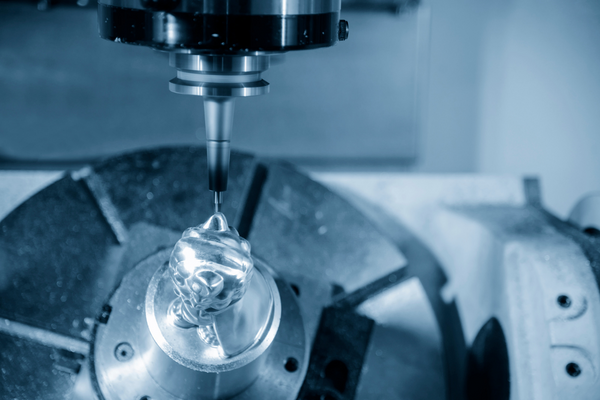5-axis CNC machining is a technology that’s made great strides in manufacturing. And if you’re wondering what the 5-axis is or how it can benefit your company, this is the article for you.

What is 5-Axis CNC Machine?
CNC milling machines are used to machine the outer surface of a cylindrical object. They can also cut slots, grooves, and pockets into solid objects. The cutting tool is mounted on a table that moves back and forth on rails and up and down for depth of cut control. The material is fed into the machine using either a V-groove or flatbed carriage system.
The five axes of motion that make up a 5-axis CNC milling machine are:
1) X-Axis – Moves the cutting tool along the length of the workpiece from left to right
2) Y-Axis – Moves the cutting tool from front to back through the center of the workpiece
3) Z-Axis – Allows for vertical movement of the cutting tool so that it may plunge into the workpiece or lift out of it
4) A rotational axis (R axis) allows for rotational movement around an imaginary center point on your workpiece. This is useful when you need to rotate a series of parts or features around an axis other than their centerline without changing their overall shape or size.
5) An angular axis (A axis), also known as a tilt axis, allows your workpiece to be tilted by a specified amount around an imaginary center point on the workpiece. This is useful for creating parts that are angled about their horizontal planes, such as table legs or chairs
Typical types of 5-axis CNC machines
Nesting 5-axis CNC machine: This type of machine allows you to make parts that fit together with other parts. For example, if you make a part that fits inside another part, the nesting 5-axis CNC machine will ensure that the two parts are fitted together perfectly.
Tapping 5-axis CNC machine: A tapping 5-axis CNC machine can thread holes in various materials, including metal and plastic. The tapping tool is attached to the end of a tool holder that moves up and down and rotates around the axis of the workpiece as it’s being threaded by the tapping tool.
Drilling 5-axis CNC machine: A 5-axis CNC machine can drill holes in various materials, including metal and plastic. The tool holder moves up and down as well as rotates around the axis of the workpiece while it’s drilling.
RTCP in 5-Axis CNC Machining Center
RTCP stands for Real-Time Control Protocol. In a 5-axis CNC machining center, RTCP is used to control the machine’s spindle. The spindle is the part of a machine that holds the cutter and moves it around as it performs its cutting operation.
In contrast to traditional CNC machining centers, which use step and direction (SDC) control, 5-axis CNC machining centers utilize RTCP control. The advantage of using RTCP is that it allows for greater quality in the parts being made by giving the operator more flexibility in their design.
The main difference between SDC and RTCP is that while SDC uses two axes to simultaneously control both directions of movement (X and Y), RTCP uses four axes (X, Y, Z, A). An operator can now use two separate axes to control each direction independently so they can cut faster or more accurately than they could use SDC alone.
The following are the advantages of using RTCP:
1. Generates programs in real-time based on customer requirements
2. The program can be modified easily during processing
3. The cost of RTCP programming is much lower than other offline programming methods

Advantages of 5-Axis Machining
As you can imagine, there are many advantages of 5-axis machining over traditional methods. Here are just a few:
Improved accuracy: The ability to move the cutter in five axes means it can be positioned much more precisely than other techniques. This improves accuracy and reduces the need for secondary operations, such as reworking or polishing parts by hand.
Better surface finish: The improved accuracy also leads to better surface finish on parts produced via 5-axis machining. This is especially true when turning solid metal blocks into cylinders or other shapes with external surfaces that must be perfectly smooth and round.
Reduced cycle times: Because 5-axis machines can cut more efficiently than 4-axis machines, they reduce cycle times while improving accuracy and surface finish.
Difference Between 3-Axis and 5-Axis Machining
A 3-axis machining center is the most basic type of CNC machine you can buy, and it’s a good choice for many small shops. But if you want to do any sort of advanced machining, or if you need to cut very hard materials like steel or titanium, then a 5-axis machine might be a better fit for your needs.
The difference between the two types of machines is that with a 5-axis machine, the cutting head can move in three degrees of freedom (X, Y, Z) and rotate around two axes (A & B). This gives you more flexibility when working with complex shapes or materials that require additional machining steps.
On a 3-axis machine, the cutting head moves only along three axes: X (left/right), Y (forward/backward), and Z (up/down). That means all 3-axis machines have one degree of freedom less than 5-axis machines: they can’t rotate around A & B axes.

Conclusion
The virtual simulation software and CNC control system are advanced, stable, and reliable. It provides various functions, such as compensation for lost tools, automatic positioning, and high multiple-point machining. Also, it makes your work easier and reduces the cost. Surely this is a good helper for your production.


